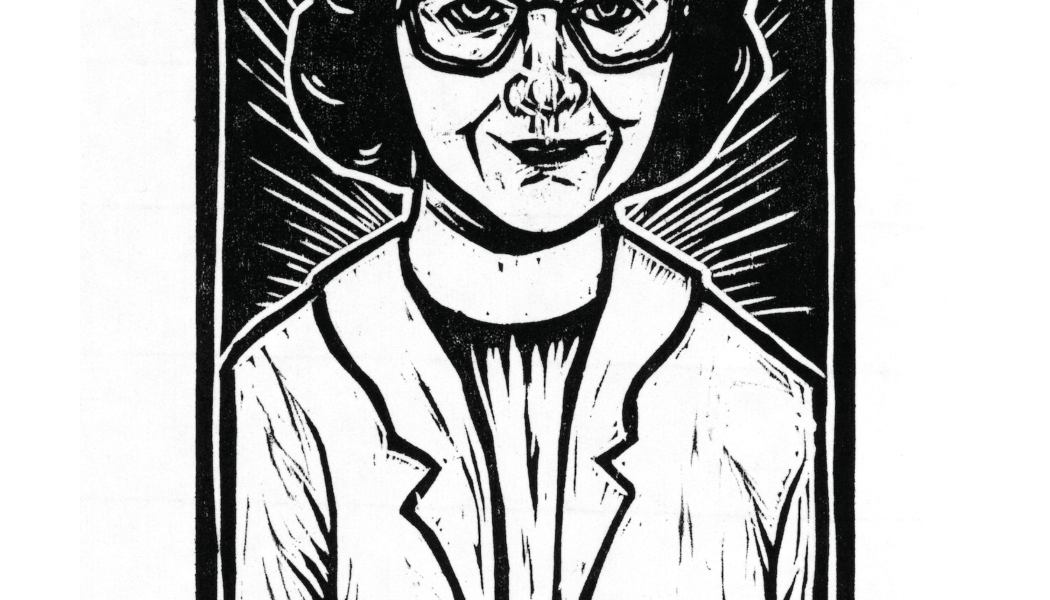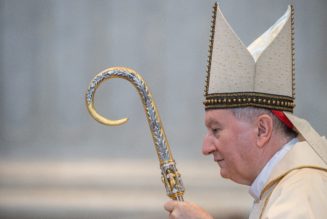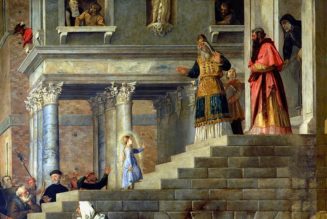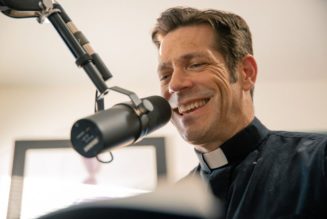To help pave the way to the National Eucharistic Congress July 17–23, 2024, we are thrilled to present the American Eucharistic Witnesses. These are holy men and women who lived, loved, and served on the very soil upon which we now stand. They all testify—in unique and powerful ways—to what it means to encounter Jesus in the Eucharist and go on mission with him for the life of the world. Each month through July 2024, we will feature a new witness. Old and young, men and women, representing different cultural families and vocations, these men and women show us—in living color—what holiness looks like. We are also thrilled to partner with American artist Connor Miller, who is creating an original woodcut print of each witness to help us visually engage with this creative new series.

The Famous Flannery Story
There is a famous story about Flannery O’Connor defending the Eucharist that every Catholic should know, and many already do. As Flannery tells it, as a young writer she was taken by some friends to a dinner party in the home of some famous New York intellectuals. For most of the evening, O’Connor sat in silence. She explains, “Having me there was like having a dog present who had been trained to say a few words but overcome with inadequacy had forgotten them.” Late in the evening, the conversation turned to the Eucharist, and the host of the dinner party informed the others that she thought of the Eucharist as a symbol, “and implied that it was a pretty good one.”2 At that, O’Connor said in a very shaky voice, “Well, if it’s a symbol, to hell with it.”3
Usually, the story ends there. It’s a powerful line by America’s greatest Catholic fiction writer, and it’s a good reminder to all of us that the Eucharist is no mere symbol; it is the Real Presence of Jesus Christ—Body, Blood, Soul, and Divinity. But that’s not the end of O’Connor’s description of the event. In fact, her reflection that follows deserves our attention: “That was all the defense I was capable of but I realize now that this is all I will ever be able to say about it, outside of a story, except that it is the true center of existence for me; all the rest of life is expendable.”4

Flannery O’Connor wrote these words in 1955, a decade before the closing of the Second Vatican Council, but her reference to the Eucharist as the true center of her existence is in accord with the Council’s teaching on the Eucharistic Sacrifice as the source and summit of the whole Christian life. As she later noted, “Christ gave us the sacraments in order that we might better keep the two great commandments. You will learn about Catholic belief by studying the sacramental life of the Church. The center of this is the Eucharist.”6 O’Connor’s life was certainly a Eucharistic one.
Finding Grace in Daily Structure
Flannery O’Connor was fifteen when her father died of lupus, and she was diagnosed with the same debilitating disease at the young age of twenty-five, just as her writing career was beginning to blossom. For the last fourteen years of her life, she lived on a working dairy farm in Milledgeville, Georgia, with her mother, Regina, and over forty peacocks. She was slowly dying, and she knew it. And she didn’t waste a minute of her time. Biographer Brad Gooch notes, “Immediately on waking, she read prayers for Prime, prescribed for six in the morning, from her 1949 edition of A Short Breviary. Following coffee, she and her mother then drove into town to attend Mass at Sacred Heart, celebrated most weekday mornings at seven.”7 After Mass, she would return home to write from nine o’clock to noon, seven days a week. In the afternoons she would read, write letters, receive guests, paint and look at, listen to, and feed her peacocks. After reading St. Thomas Aquinas for about twenty minutes,8 she would go to bed at nine o’clock.9
O’Connor’s life was highly structured and predictable. At first glance, such a habit of being may appear boring and uneventful. But upon closer look, it becomes clear that O’Connor’s greatness as a writer came from her centeredness as a Catholic. “I believe what the Church teaches – that God has given us reason to use and that it can lead us toward a knowledge of him, through analogy; that he revealed himself in history and continues to do so through the Church, and that he is present (not just symbolically) in the Eucharist on our altars. To believe all this I don’t take any leap into the absurd. I find it reasonable to believe, even though these beliefs are beyond reason.”10 She knew who she was and whose she was, and she structured her day in such a way that she would participate in the very life of God every morning at Mass at Sacred Heart Parish. The God of the universe would make himself present through a tiny white host, and she would receive him; she would become one with him in Holy Communion. She was then sent from the celebration of the Eucharist back to her farm, where she would use her God-given gifts as a narrative artist for the remainder of her morning.

A Short but Faithful Life
We could say that, in her disciplined three hours of daily writing, she was glorifying God by her life. Writing was an essential part of her vocation, and she made sure that she structured her day so that she could respond to that vocational call faithfully, every day. And that is exactly what she did. Even in her final days of battling lupus in the hospital, she was still working on edits of her short stories as best she could, until she breathed her last on August 3, 1964. Her funeral Mass was offered the very next day at Sacred Heart Parish for the repose of her soul and for the consolation of those who loved her.
Richard Gilman of the New York Review of Books once wrote of O’Connor, “She went to Mass every day, said grace, and wasn’t ashamed of saying ‘Our Lady.’”12 Not a bad model for the National Eucharistic Revival, if you ask me.
Fr. Damian Ference is a priest of the Diocese of Cleveland where he serves as Vicar for Evangelization, Secretary for Parish Life and Special Ministries, Professor of Philosophy at Borromeo Seminary and co-director of the diocesan Eucharistic Revival. He holds a licentiate in philosophy from The Catholic University of America and a doctorate in philosophy from the Pontifical University of St. Thomas Aquinas in Rome. He writes regularly on the intersection of faith and culture for a variety of outlets and is the author of the award-winning book, The Strangeness of Truth (Pauline Books & Media, 2019) and Understanding the Hillbilly Thomist (Word on Fire, 2023). Fr. Ference is the founder and director of Tolle Lege Summer Institute and is a lifetime member of the Flannery O’Connor Society. @frference
Help the children and youth in your life grow closer to Jesus in the Eucharist through the witness of Flannery O’Connor today! Download Katie Bogner’s children’s activities—perfect for home, classroom, and parish settings!
1. Flannery O’Connor, The Habit of Being, ed. Sally Fitzgerald (New York: Farrar, Straus, and Giroux, 1979), 125.
2. Ibid.
3. Ibid.
4. Ibid.
5. Lumen Gentium, no. 11. (The reference for the Eucharistic Sacrifice as ‘source and summit of the whole Christian life’ in Lumen Gentium is derived from Pope Pius XII’s encyclical Mediator Dei, published November 20, 1947. It is likely that O’Connor was familiar with this encyclical.)
6. Flannery O’Connor, The Habit of Being, ed. Sally Fitzgerald (New York: Farrar, Straus, and Giroux, 1979), 346.
7. Brad Gooch, Flannery: A Life of Flannery O’Connor (New York: Little, Brown and Company, 2009), 222–223.
8. “So I couldn’t make any judgement about the Summa, except to say this: I read it for about twenty minutes every night before I go to bed.” HB, 93.
9. “I got to bed at nine and am always glad to get there.” HB, 236.
10. Flannery O’Connor, The Habit of Being, ed. Sally Fitzgerald (New York: Farrar, Straus, and Giroux, 1979), 479.
11. “I asked the doctor if I could sit up at the electric typewriter and work. You can work, he says, but you can’t exert yourself.” HB, 588.
12. Richard Gilman, “On Flannery O’Connor”, The New York Review of Books, 21 August 1969, in Conversations with Flannery O’Connor, ed. Rosemary M. Magee (Jackson: University Press of Mississippi, 1988), 54.








